Have you ever wondered why the flute produces sound? Understanding this might enhance your performance skills. Factors such as air speed and harmonics are crucial aspects to grasp through sensory experience. Here, I’d like to delve into the principles behind these concepts.
Air Reed
Unlike instruments like the saxophone, the flute does not have a reed that converts breath into vibrations. Therefore, in the case of the flute, we refer to it as an ‘air reed.’ Essentially, it creates vibrations using only breath.
So, how does the flute create vibrations using only breath? It relies on a phenomenon called the ‘Karman vortex street,’ where placing an obstacle in a fluid (like air) causes alternating vortices to form behind it. This phenomenon causes the air inside the flute to vibrate. It’s difficult to explain well with just words, so let me illustrate it with a diagram.
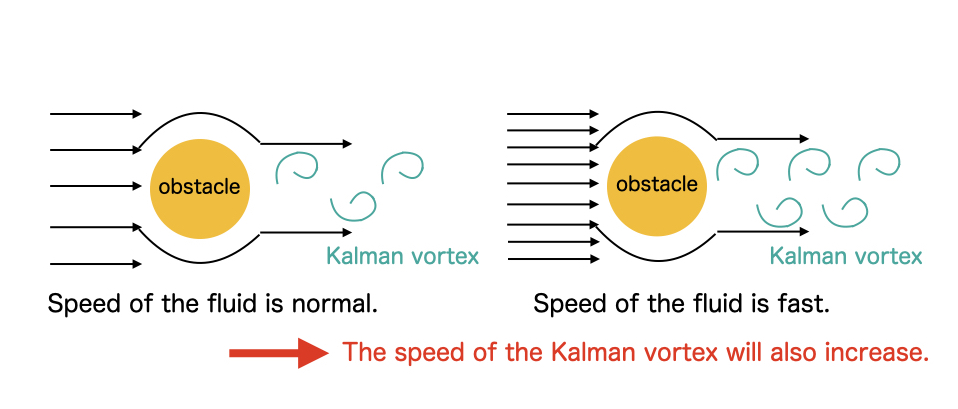
Think of the arrows as fluid flow, and imagine the yellow circles as obstacles. When the speed of the fluid exceeds a certain threshold, Karman vortices form behind the obstacle. As the speed of the fluid increases, the Karman vortices become finer and the oscillations of these vortices become faster.
Now let’s consider this in the case of the flute.
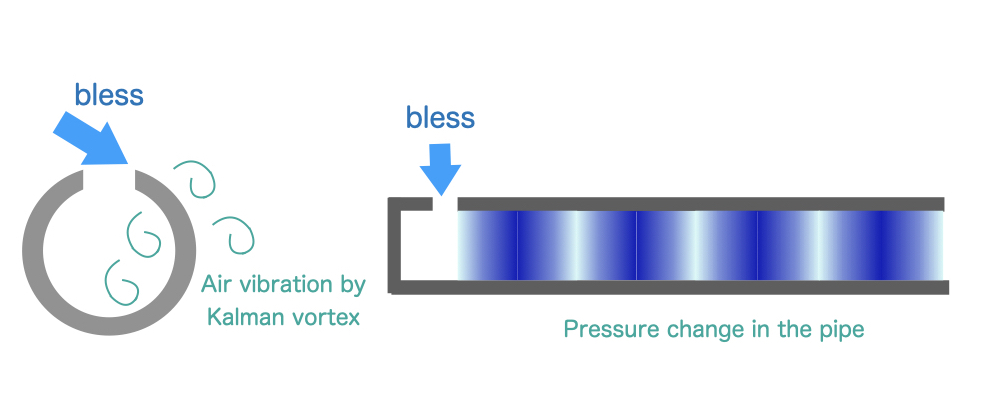
When playing the flute, you blow air towards the edge of the lip plate. We consider this air as fluid. With the flute, you blow as if half of the air goes inside and the other half goes outside. In other words, the edge of the lip plate acts as an obstacle to the fluid, causing Karman vortices to form behind it, which makes the air inside vibrate. The vibration of the air is a change in pressure, which propagates inside the tube and resonates to produce sound. (Further details will be explained later.)
Earlier, it was mentioned that the faster the speed of the fluid, the faster the vibrations of the Karman vortices. Therefore, the faster the speed of the air you blow, the faster the vibrations and the higher the frequency of the sound produced. Higher frequency means higher pitch, so for higher notes, you need to blow air at a faster speed.
Resonance of Open Tube
Sound is the vibration of air, but slight vibrations are imperceptible to the human ear. Therefore, vibrations need to be sufficiently strong. The instrument responsible for this role is the flute body.
In the case of the flute, both ends of the flute, the embouchure hole and the open end of the footjoint, are open, making it an open tube. Using this open tube, specific frequencies of sound can resonate and amplify into strong vibrations. It is these resonant frequencies that we hear.
Now, how are these frequencies determined? They are determined by the length of the tube. This is also difficult to explain without a diagram, so let me illustrate it.
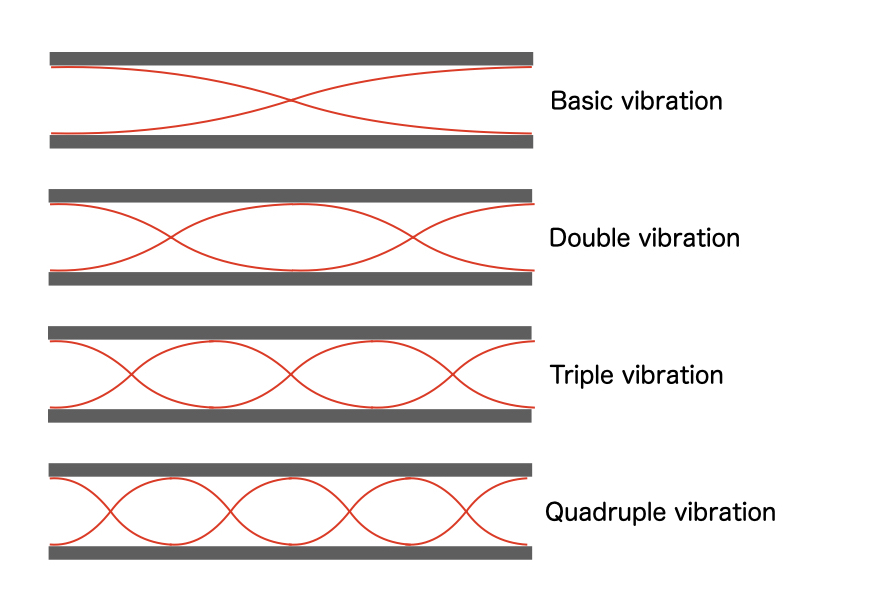
The vibration of sound waves reflects at the end of the flute tube. (It may seem strange, but even though it is open, it reflects.) There are specific frequencies where the advancing wave and the reflected wave overlap and reinforce each other. These are the resonant frequencies depicted in the diagram above. Waves at these frequencies appear to vibrate as if they are stationary, hence they are called standing waves. In the case of an open tube, due to free-end reflection, resonance occurs when half the wavelength of the sound wave exactly matches the length of the tube. This becomes the fundamental vibration.
Sounds at frequencies that are double, triple, or quadruple the fundamental vibration also resonate. These are known as harmonics or overtones.
However, with just these, only specific frequencies (pitches) can be produced. Therefore, the flute body has many tone holes that can be covered or uncovered with fingers. By adjusting these, the length of the tube can be altered, allowing for various pitches to be produced.
Returning briefly to the discussion of the air reed, since resonant frequencies can be adjusted with the fingers, it’s not just about vibrating the air; it’s about creating vibrations of Karman vortices close to the resonant frequencies of the sound. Therefore, besides finger placement, it’s essential to be conscious of the speed of airflow depending on the pitch. Lower pitches require slower airflow, while higher pitches require faster airflow. If you can create vibrations in the airflow that are close to the frequency of the desired pitch right from the breath, it becomes much easier to produce the sound.
Harmonics
In the case of the flute, all notes in the first octave (low register) are produced using the fundamental vibration, while all notes from the second octave and higher are produced using harmonics. You can produce higher notes with the same fingering by increasing the speed of your breath.
I believe practicing harmonics is crucial for flute players, and I would like to explain the rationale behind this practice. Let’s assume we are explaining this with the note D in the low register.
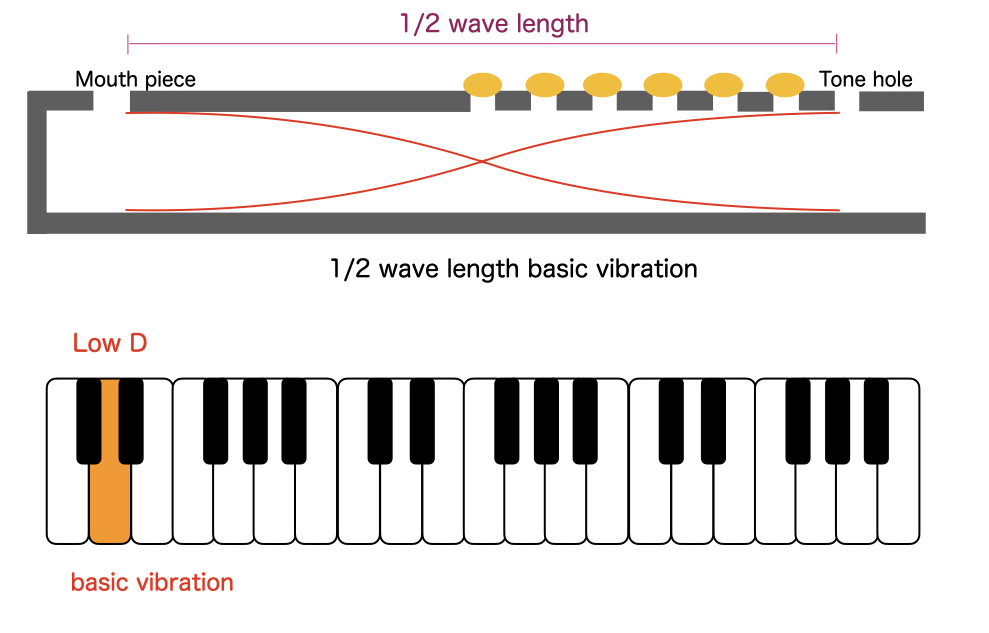
The low D is a fingering with only the pinky finger of the right hand separated, so only the sound hole at the very tip is an open tube. In this case, the distance between the mouth piece and the tone hole is half the wavelength of the resonant sound (although there are complicated calculations involved). This is the fundamental vibration of the D.
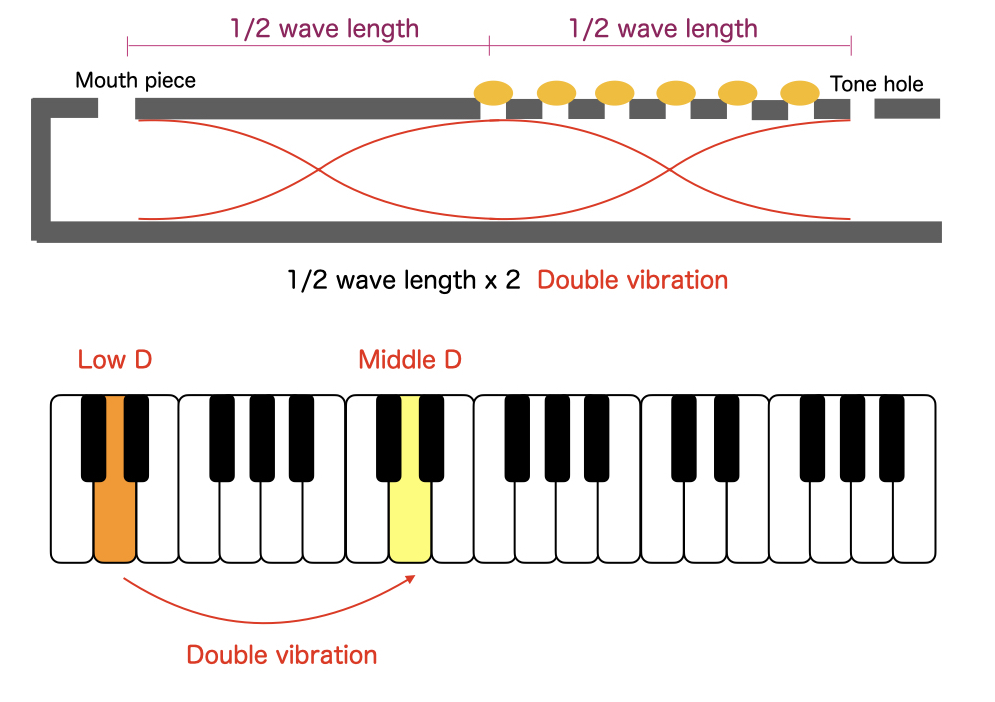
If you keep this fingering and increase the speed of your breath, you will be able to get an octave higher D. The reason for this is that vibrations twice as high as the fundamental vibrations will resonate better in the tube. When the number of vibrations (frequency) is doubled, the pitch goes up an octave.
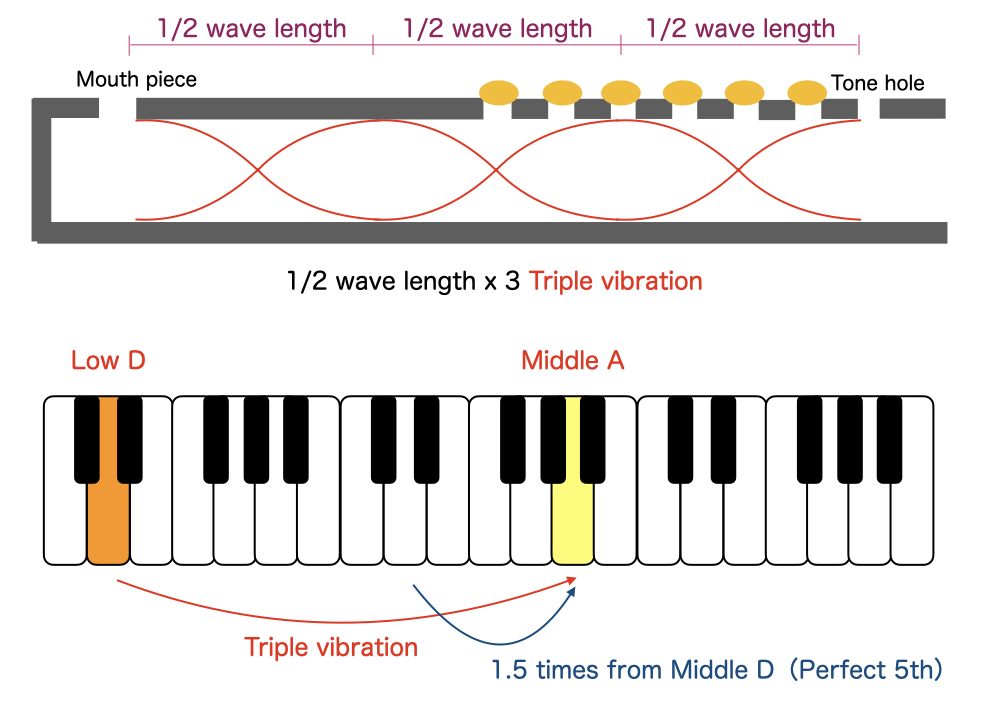
Using the same fingering and increasing the speed of the breath further, a note three times the fundamental vibration will resonate. This is not a D note, but a medium A. The reason for this is that the triple harmonic is 1.5 times the frequency of the middle D note. When the frequency is 1.5 times higher, the pitch is a perfect fifth, so five degrees higher than D is A.
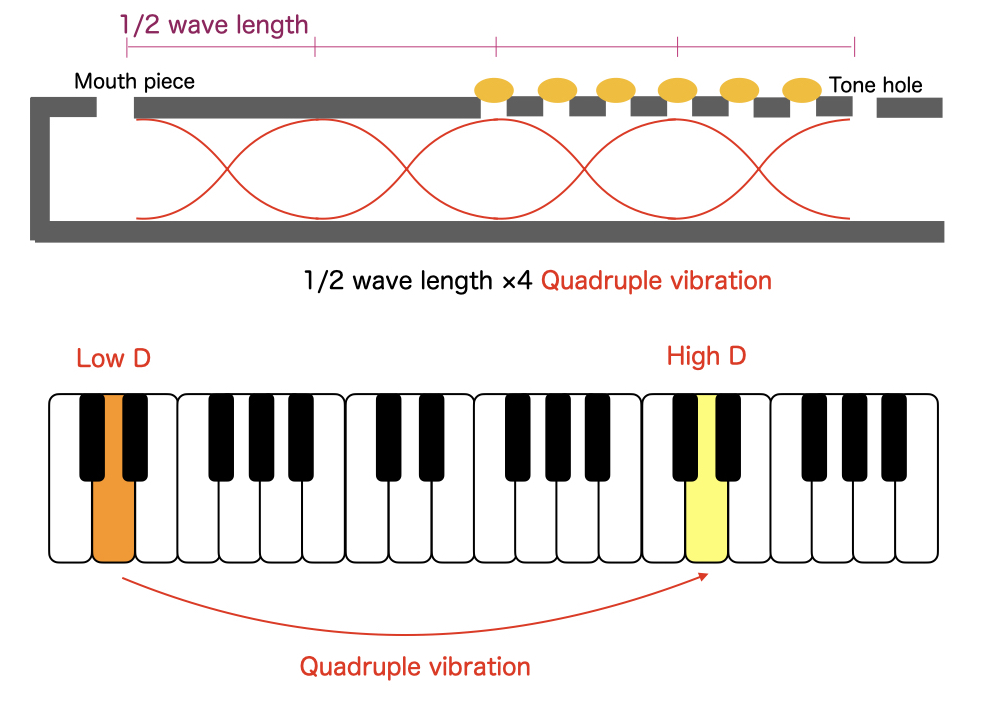
If you increase the speed of your breath, you will get a high D, which is a quadruple vibration. This is twice as high as the middle D note, so it is an octave higher and becomes a high D.
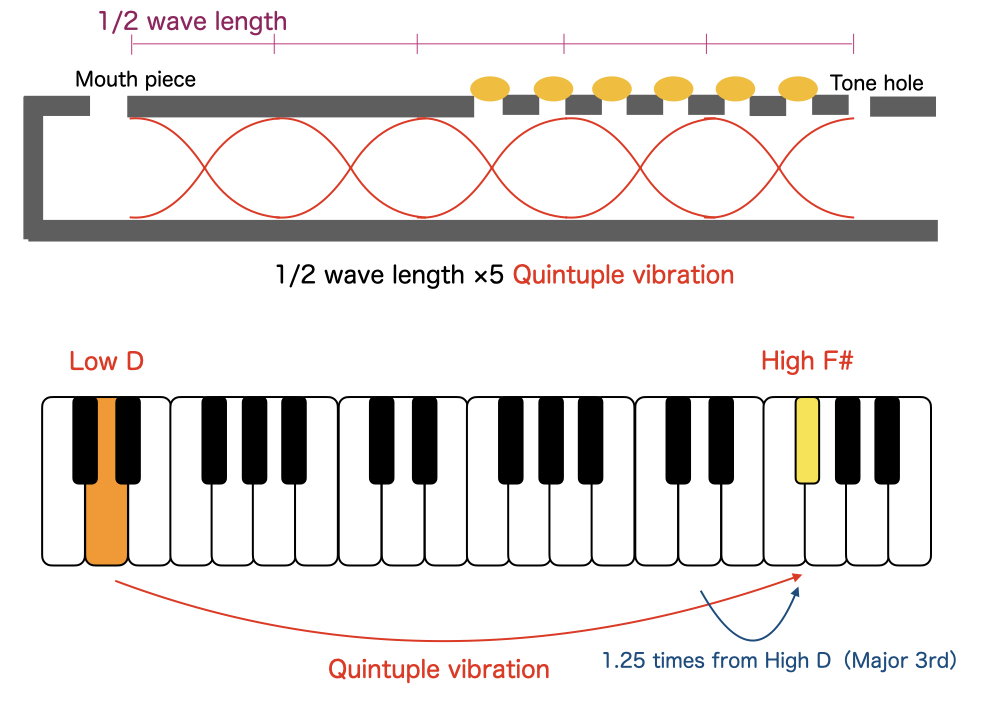
This is where it starts to get difficult, but if you increase the speed of your breath, you will get a high F#. This is a 5-fold vibration. This is 1.25 times higher than the high D which is 4 times higher than the low D. When the frequency is increased by 1.25 times, the major third note is produced.
There are some that are 6 times, but I’ll leave it at that. You can see from this that you can get quite a variety of sounds with just harmonics. But it’s hard to go back and forth between these sounds with just harmonics. (That’s why it’s great for basic practice.) For this reason, the sound hole in the belly of the standing wave is opened for the middle and high notes so that harmonics can be easily produced.
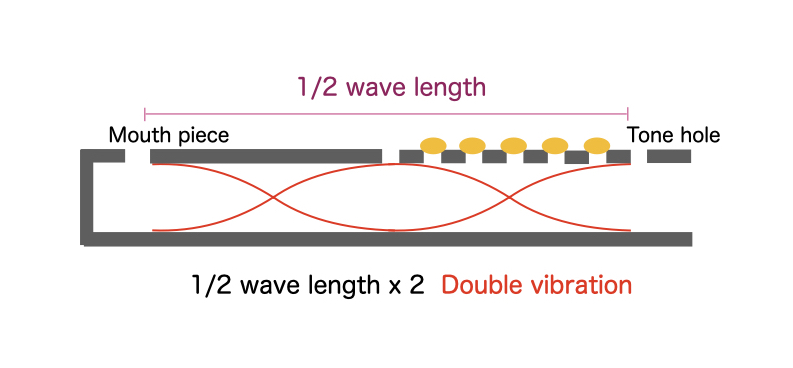
This is an example of the middle D note. When you play the middle D note, you release the index finger of your left hand (the uppermost sound hole), right? This position is half the wavelength of the low D. If you open this hole, sound reflections will be generated here as well, making it easier to create standing waves of double vibration.
The same is true for the harmonics of other pitches, and opening the sound hole in the belly of the standing wave makes it easier to produce harmonics. When it comes to the higher notes in the upper register, there are many fingers that are held down every other note, right? That’s because of the quadruple or quintuple vibration, and there are many standing wave bellies, so we open up various holes.
I’ve written a long and complicated story, but what I wanted to say was…
It’s important to practice Harmonics!
If you can learn to control pitch (overtones) not only with your fingers but also with the speed of your breath, you will be able to move from low notes to high notes with ease.